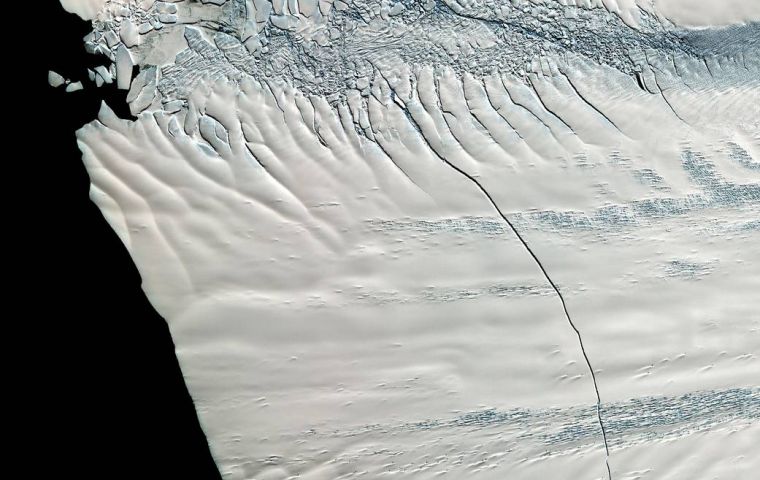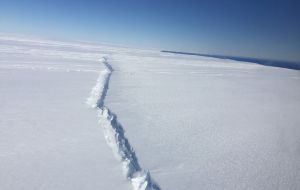MercoPress. South Atlantic News Agency
Jumbo 100sq-miles iceberg breaks off from Pine Island Glacier in West Antarctica
 The Pine Island Glacier is one of the largest in West Antarctica, a region that is currently Antarctica’s biggest ice loser. (Pic NASA)
The Pine Island Glacier is one of the largest in West Antarctica, a region that is currently Antarctica’s biggest ice loser. (Pic NASA)  The Delft University of Technology in Netherlands, posted a satellite image showing that Pine Island had “calved,” a piece of ice about 103 sq miles in area.
The Delft University of Technology in Netherlands, posted a satellite image showing that Pine Island had “calved,” a piece of ice about 103 sq miles in area.  The rectangular piece (four times Manhattan) of ice appears to have lost some of its shape immediately as smaller pieces splintered off.
The rectangular piece (four times Manhattan) of ice appears to have lost some of its shape immediately as smaller pieces splintered off. An enormous Antarctic glacier has given up an iceberg over 100 square miles in size, the second time in two years it has lost such a large piece in a process that has scientists wondering if its behavior is changing for the worse.
The Pine Island Glacier is one of the largest in West Antarctica, a region that is currently Antarctica’s biggest ice loser. Pine Island, which loses an extraordinary 45 billion tons of ice to the ocean each year (equivalent to 1 millimeter of sea level rise every eight years), is 25 miles wide where its floating front touches the sea, and rests on the seafloor in waters over half a mile deep. The single glacier alone contains 1.7 feet of potential global sea level rise and is thought to be in a process of unstable, ongoing retreat.
That’s why scientists are watching it closely, and on Saturday, Stef Lhermitte, a satellite observation specialist at Delft University of Technology in the Netherlands, posted a satellite image showing that Pine Island had “calved,” or broken off a piece of ice about 103 square miles in area. (For comparison, Manhattan is 22.83 square miles in size.) The rectangular piece of ice then appears to have lost some of its shape immediately as smaller pieces splintered off.
“It’s the fifth large calving event since 2000,” Lhermitte said. “This one and 2015, they were much further inland than the previous ones. So there has been a retreat of the calving front, specifically between 2011 and 2015.”
According to researchers at NASA and a team of scientists studying Pine Island, Seongsu Jeong and Ian Howat of Ohio State University, the Pine Island Glacier has developed a troubling new way of losing ice, with rifts forming in the center of its floating ice shelf from beneath, rather than at the sides, the traditional manner. They suspect this is a function of warmer ocean waters reaching the base of the glacier and weakening it.
“We predicted that the rifting would result in more frequent calving, which is what’s happening here,” said Howat by email. “If new rifts continue to form progressively inland, the significance to ice shelf retreat would be high.”
Last fall, NASA’s Operation IceBridge mission snapped a photo of the rift in Pine Island Glacier that would lead to the latest calving event.
The ice loss in this event is nowhere near the size of the much publicized loss of an enormous ice island from the Larsen C ice shelf this year. However, in terms of sea level rise, changes at the Pine Island Glacier are far more consequential.
The current break was in the glacier’s floating ice shelf, which extends out over a deep ocean cavity. Further inland, the floating portion of the glacier ends and the ice slopes down and touches the seafloor at a vulnerable point called the “grounding line.” Changes in the temperature of waters reaching the grounding line in recent decades are widely believed to be the reason that Pine Island Glacier has been thinning and losing so much ice.




Top Comments
Disclaimer & comment rulesCommenting for this story is now closed.
If you have a Facebook account, become a fan and comment on our Facebook Page!